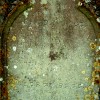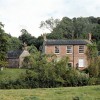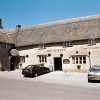Whenever the name Churchill is mentioned people naturally think of Sir Winston of the Second World War, twice Prime Minister, and associate his family with Blenheim Palace in Oxfordshire. After all, this was the seat of the Churchills as the Dukes of Marlborough in the 18th century. And, true enough, it was here in 1874 that the soldier statesman Sir Winston of the 20th century was born.
Less well known (if at all) is the perhaps not-so-surprising fact that the great man’s earliest documented ancestor was another Sir Winston, though one who never lived outside of the 17th century.
But this earlier Winston Churchill was no Oxfordian; nor was he a Londoner or a native of the home counties. In fact he was of true Dorset origin, first seeing the light of day in a remote farmhouse situated in the mid north-west parish of Glanvilles Wootton, called Round Chimneys. The three evenly spaced small chimneys which give the farm its name appear in an relatively early photograph, along the apex of a roof sloping much further down at the rear than at the front, but the house also has an economy of windows and smooth-rendered walls giving it the appearance of an American-style farmhouse that would not look out of place in the Allegheny foothills of Pennsylvania.
In 1620 however, when the earlier Winston Churchill was born here, the farmhouse would likely have looked quite different. Although there appear to be no records of who his parents were, they evidently brought young Winston up in the Royalist tradition of a Cavalier. He became a Member of Parliament as well as holding a position in the Royal household known as the Board of Green Cloth. As a Royalist he fought on the side of Charles 1 in the Civil War, but following the defeat of Charles he had to forfeit his estates. As a member of the Board of Green Cloth Churchill may have had a hand in formulating resolutions such as the one passed in June 1681 that cherry tarts should be issued to the Maids of Honour instead of gooseberry tarts, as cherries were cheaper. Later he also joined the only recently formed Royal Society.
It was noted that Winston was a surprisingly superstitious man. Harking on the fact that he happened to be born and baptised on a Friday, he went through life believing it to be his lucky day. So much so evidently, that he saw to it that he married and was even knighted on Friday too, though it is not recorded whether, as he believed he would, he died on that day.
As a loyal and respected member of the Royal household Churchill received a knighthood at some time, either from Charles 1 or 11. In 1648 his daughter Arabella was born, followed in 1650 by the arrival of a son, John, then another son, Charles, after John. It was John Churchill who grew up to be the first Duke of Marlborough and who somewhat eclipsed the obscure and lesser-known standing of his father. But like Winston, John Churchill (or “Corporal John” as he came
to be known) became a Royalist soldier whose advancement was spurred on by his sister Arabella when she became mistress to the Duke of York, later James 11.
When the first Winston did die in 1688 at the age of 68, it was not before he had left a written legacy in the form of a history of the English kings titled Divi Britannici.
John Churchill, who as we have seen was also born at Round Chimneys, was brought up as an Anglican and educated at St Paul’s School in London, where the masters failed to inspire him with any tastes in literature, though he was handsome, with attractive manners. In 1678 he married Sarah Jennings, a lady-in-waiting to Princess Anne, and was raised to the peerage in 1682. He once saved the life of the Duke of Monmouth at Maastricht, though this would later prove to have been a futile and undeserved intervention. For by 1685 Churchill was second in commandof the King’s troops dispatched to suppress Monmouth’s western rebellion, and so was largely responsible for the Duke’s capture and execution. It was as if Churchill had saved a life only to take it later.
Before becoming the founder of the Marlboroughs John Churchill became 1st Baron of Sandridge. Under this title and at the head of 5000 men he defected to William, Prince of Orange in 1688, once James 11’s Catholicism had become notorious and at odds with Churchill’s Anglicanism. After campaigning in the Netherlands and Ireland, in 1701 Churchill was made 1st Duke of Marlborough by Queen Anne and sent by her as Commander-in-Chief of the Anglo-Dutch alliance to fight in the War of Spanish Succession, which brought Gibraltar under British colonial dependency.
Between 1702 and 1711 Churchill was primarily engaged in fighting the French, where his fame reached a climax in the campaign of Ramillies. He drove the French from occupation of Spanish Gelderland, but Churchill’s crowning glory came when he fought and won the Battle of Blenheim in 1704.
The outcome of these campaigns made this Dorset soldier-farmer’s son largely responsible for altering the course of European history by thwarting France’s attempts to join forces with the Bavarians. For these actions a grateful King and country rewarded John Churchill with the gift of the estate of Woodstock Manor in Oxfordshire. Here Churchill built the great palace that upon its consecration has honoured and perpetuated the place name of his crowning military triumph in its own.
Of the Duke, it was said that he never lost a battle or failed a siege. His domestic life however, somewhat tainted the success of his military career. He had to suffer intrigues perpetrated by his wealthy wife who was keeper of the Privy Purse for Queen Anne, as well as becoming her confidant. In 1711 his standing with the Whigs, upon whom he depended, was fatally undermined when, making an ill-judged demand that he should hold a Captain-Generalship for life, he gave his enemies a chance to topple him. Churchill was recalled and politically savaged in Parliament.
Rather than have to face the hostility of his compatriots, the Duke made a quiet retirement abroad. He was made Captain-General by George 1, though he was never considered trustworthy again, and after some years in declining health he died from a stroke in 1722.
Churchill’s eldest daughter was Lady Anne, who married Charles Spencer, 3rd Earl of Sunderland in 1700. Their son, also called Charles, became the 3rd Duke of Marlborough and 5th Earl of Sunderland upon the death of Lady Anne’s sister, who was Duchess of Marlborough in her own right after Anne and Charles had pre-deceased her.
So Round Chimneys Farm played a direct role as the setting for the roots of two of the country’s leading aristocratic families. However, the farm is not the only Dorset connection with the Churchill’s. Canford House, for instance, was once the home of Lady Wimborne, wife of Ivor Guest but formerly Cornelia Spencer Churchill, sister of the high Tory statesman Lord Randolph Churchill. By his American wife Jennie Jerome, Randolph was the father of the latter Sir Winston, who was therefore Cornelia Wimborne’s nephew. Furthermore, Sir Winston’s own son Randolph married Pamela Digby, heiress of the Digby’s of Minterne House.
The wheel comes full circle when we learn that after the Reformation Winchester College granted Minterne House, originally the Manor of Cerne Abbey, to none other than the first Sir Winston Churchill. He in turn left it to his younger son, General Charles Churchill, who also owned a town house in Dorchester which later burnt down in a fire in which his widow perished.
Note: We have received an email from a descendant of the Winston family informing us that the parents of The First Winston Churchill (1620-88) were John Churchill and Sarah Winston, daughter of Sir Henry Winston of Standish in Gloucestershire. Sir Winston received the ‘Winston’ from his mother’s maiden name to keep it in the family. Sir Henry Winston’s line goes back to the Winstons of Tre- Wyn, Pandy, Monmouthshire, Wales who were knights and later gentry.









